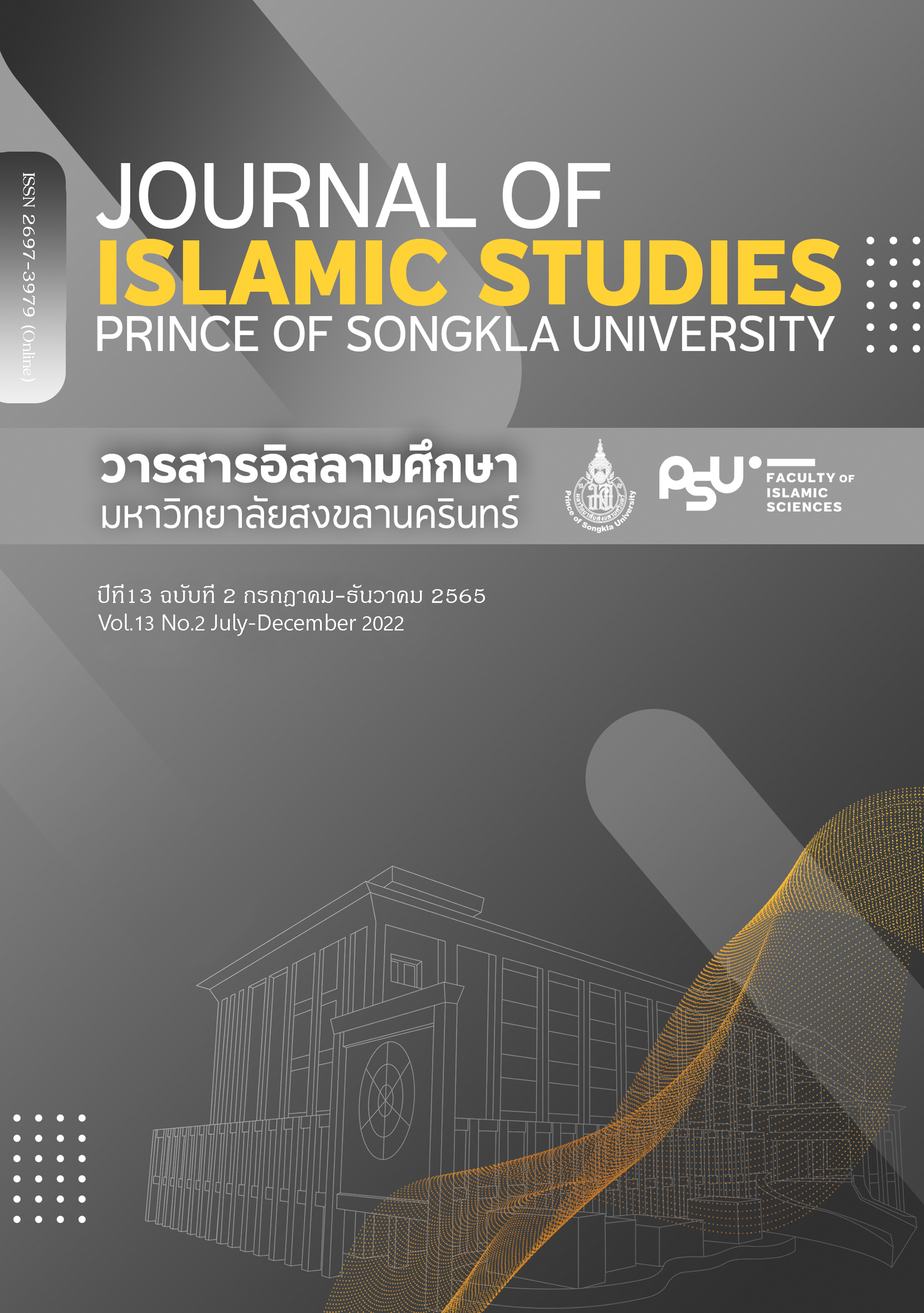ความเป็นมลายูของนักศึกษามลายูมุสลิมไทยในประเทศมาเลเซีย
คำสำคัญ:
นักศึกษา, มลายู, มาเลเซียบทคัดย่อ
วัตถุประสงค์ เพื่อทำความเข้าใจและอธิบาย ความหมายความเป็นมลายูของนักศึกษามุสลิมไทยที่ถูกประกอบสร้างในประเทศมาเลเซีย
วิธีการศึกษา ใช้การวิจัยเชิงคุณภาพด้วยวิธีการศึกษาจากเอกสาร สัมภาษณ์ และสังเกตการณ์แบบมีส่วนร่วมกับกิจกรรมนักศึกษามลายูมุสลิมจากประเทศไทยที่ไปศึกษาในประเทศมาเลเซียระดับอุดมศึกษา ตั้งแต่สิงหาคม 2558 ถึง มีนาคม 2563 ประกอบด้วยกลุ่มนักศึกษาที่เข้าไปศึกษา ณ University Utara Malaysia (UUM) และ International Islamic University Malaysia (IIUM) มหาวิทยาลัยละ 10 คน และบุคคลที่เกี่ยวข้อง ประกอบด้วย เจ้าหน้าที่ที่เกี่ยวข้อง จากศูนย์อำนวยการบริหารจังหวัดชายแดนภาคใต้ (ศอ.บต.) จำนวน 2 คน กงสุลไทยหรือเจ้าหน้าที่สถานทูตไทยในประเทศมาเลเซีย จำนวน 2 คน นักศึกษาไทยที่ไม่ใช่นักศึกษาชาวมลายูมุสลิมในจังหวัดชายแดนภาคใต้ มหาวิทยาลัยละ 5 คน นักวิชาการในพื้นที่ ที่สำเร็จการศึกษาจาก University Utara Malaysia (UUM) และ International Islamic University Malaysia IIUM) 4 คน
ผลการวิจัย พบว่า การแสดงออกซึ่งความเป็นมลายูของนักศึกษา IIUM กับ UUM มีความแตกต่างอย่างเด่นชัด ด้วยข้อค้นพบที่ชี้ให้เห็นว่า IIUM มีชมรมมลายูที่แสดงออกซึ่งความเป็นตัวตนมลายูอย่างชัดเจน เช่น การใช้ภาษาและการแต่งกาย รวมไปถึงกิจกรรมต่าง ๆ ในขณะที่นักศึกษามลายูมุสลิมไทยใน UUM กลับสะท้อนความเป็นไทยมากกว่าความเป็นมลายูในทุก ๆ กิจกรรมที่อธิบายถึงตัวตนความเป็นนักศึกษาไทยในมาเลเซีย เช่น การแสดงออกผ่านกีฬามวยไทย
การนำผลวิจัยไปใช้ ในขณะที่นักศึกษามลายูมุสลิมไทยในประเทศมาเลเซียอีกกลุ่มที่เรียกตัวเองว่า “ชาวฟาฏอนี” หรือ “กลุ่มนักศึกษามุวัลลัด” มีปฏิสัมพันธ์กับนักศึกษามลายูมุสลิมไทยในพื้นที่ชีวิตของตัวเองผ่านกิจกรรมต่าง ๆ ที่สามารถใช้ภาษาอาหรับและภาษามลายูในการสื่อสารได้เท่านั้น ชี้ให้เห็นว่าพื้นที่ชีวิตของนักศึกษาที่เรียกตัวเองว่า “ชาวฟาฏอนี” มิใช่มีเพียงประเด็นทางด้านภาษาในการปรับตัวและต่อรองเพียงอย่างเดียว หากแต่เป็นเรื่องของการสร้างพื้นที่ของตัวตนความเป็นมลายูที่สามารถสื่อสารอย่างเข้าใจได้
เอกสารอ้างอิง
Aimauryut, S. (2016). It is hard to be Melayu. Matichon.
Che Man, W. K. (1990). Muslim Separatism: The Moros of Southern Philippines and the Malays of Southern Thailand. Oxford University Press.
Idris, A. (1995). Tradition & cultural background of the Patani Region, in Volker Grabowskyed). Regions & National Integration in Thailand 1892-1992. Harrassowitz Verlag.
Madmarn, H. (2011). Egypt’s influence on the education of Thai Muslims from The Nasser Era to the present. In Kamaruzzaman Bustamam-Ahmad & Patrick Jory (Eds.), Islamic studies & Islamic education in contemporary Southeast Asia (pp. 29-40). Yayasan Ilmuwan.
Mohamad, M. A. (2013). Be-longing: Fatanis in Makka & Jawi. [Doctoral dissertation, Havard University]. Digital Access to Scholarship at Havard.
Pawakapan, N. (2015). chūan thok chāt læ chāttiphan [Discussion to National and Ethnic]. Siam Pritat.
Prachuabmoh, C. (1980). The role of women in maintaining ethnic identity and boundaries: a case of Thai-Muslims (the Malay speaking group) in southern Thailand. [Doctoral dissertation, University of Hawaii]. WorldCat.
Wisetreecha, B. (2015). Saints and sinners and morals on the road: Homeless life in Manila. Indo-China@Crossroad Southeast Asian Review.
Wisetpricha, B. (2016). “They deserved it”: The “normality” of violence faced by Homeless people in Manila, the Philippines. Journal of Human Rights and Peace Studies, 2(1), 103-140. https://so03.tci-thaijo.org/index.php/HRPS/article/view/163855
ดาวน์โหลด
เผยแพร่แล้ว
รูปแบบการอ้างอิง
ฉบับ
ประเภทบทความ
สัญญาอนุญาต
ลิขสิทธิ์ (c) 2022 วารสารอิสลามศึกษา มหาวิทยาลัยสงขลานครินทร์

อนุญาตภายใต้เงื่อนไข Creative Commons Attribution-NonCommercial-NoDerivatives 4.0 International License.
บทความทุกเรื่อง ที่ได้รับการตีพิมพ์ในวารสารอิสลามศึกษาเป็นแนวคิดของผู้เขียน มิใช่เป็นความคิดเห็นคณะผู้จัดทำและมิใช่ความรับผิดชอบของคณะวิทยาการอิสลาม กองบรรณาธิการไม่สงวนสิทธิ์การคัดลอก แต่ให้มีการอ้างอิงแสดงที่มา






